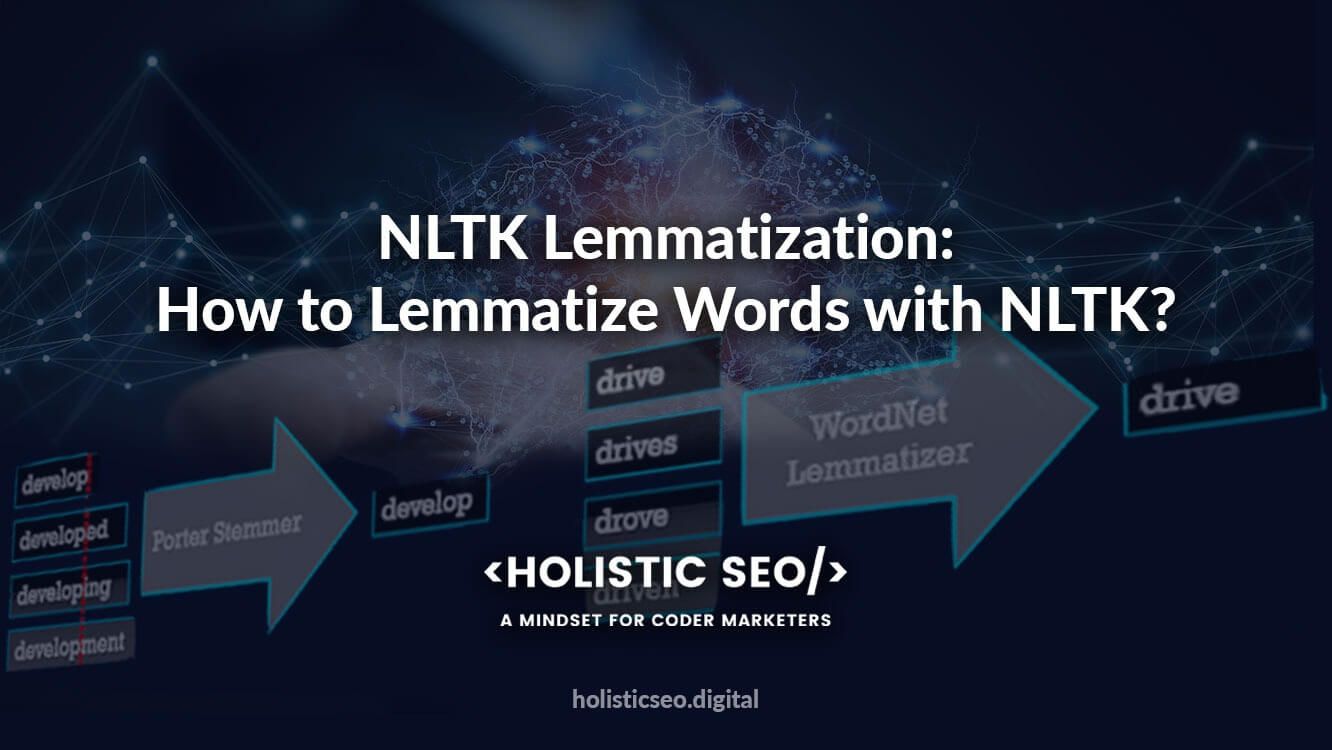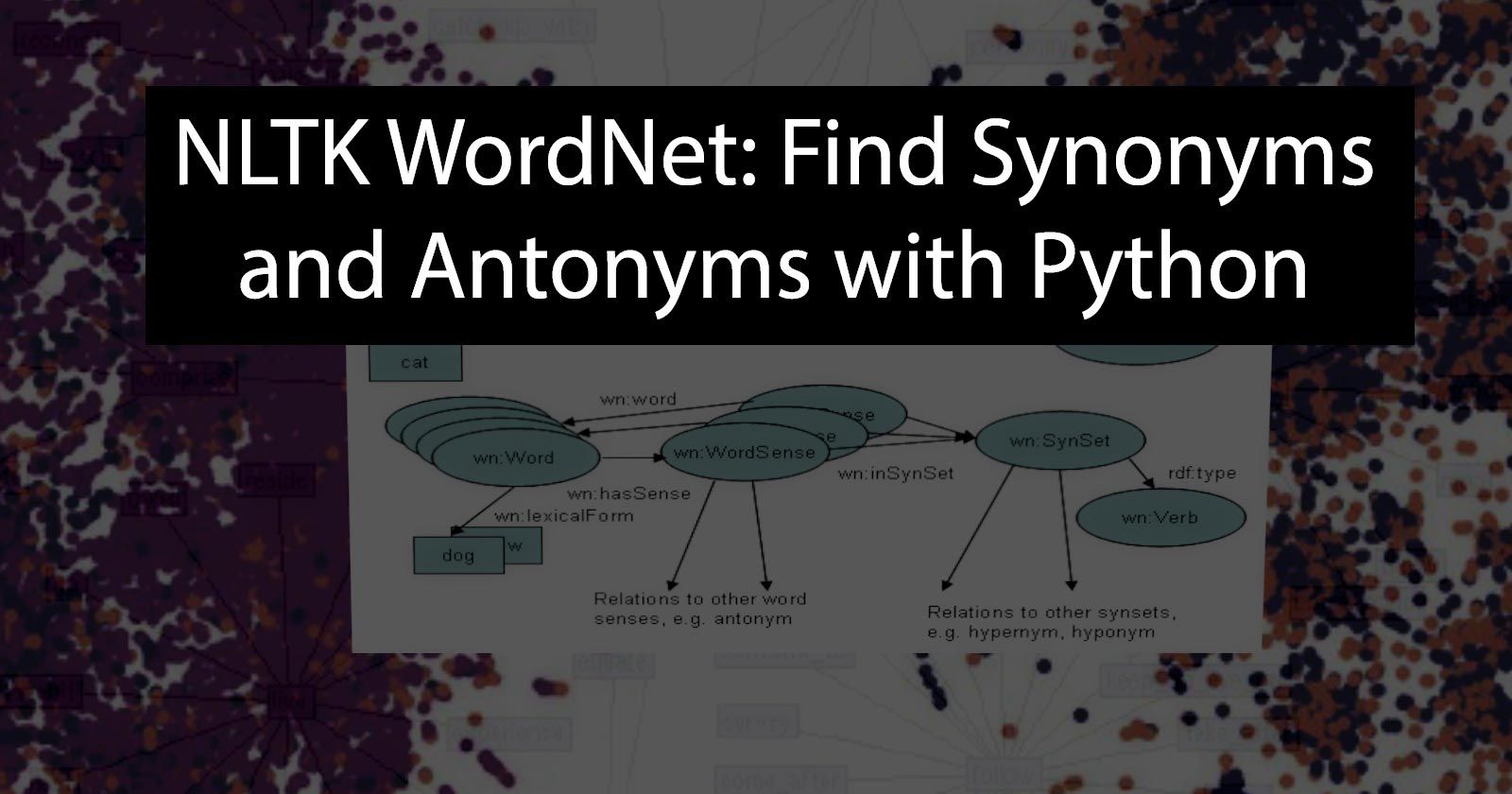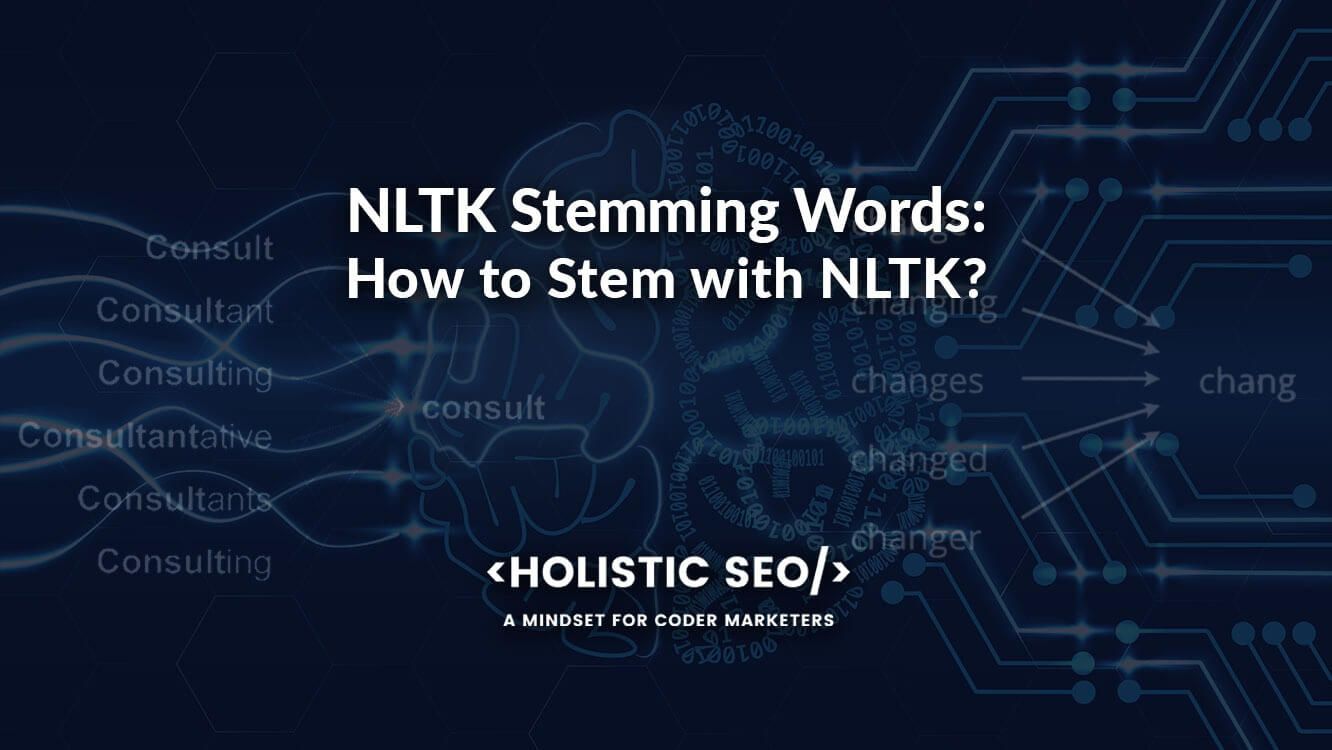NLTK Lemmatization is the process of grouping the inflected forms of a word in order to analyze them as a single word in linguistics. NLTK has different lemmatization algorithms and functions for using different lemma determinations. Lemmatization is more useful to see a word’s context within a document when compared to stemming. Unlike stemming, lemmatization uses the part of speech tags and the meaning of the word in the sentence to see the main context of the document. Thus, NLTK Lemmatization is important for understanding a text and using it for Natural Language Processing, and Natural Language Understanding practices. NLTK Lemmatization is called morphological analysis of the words via NLTK. To perform text analysis, stemming and lemmatization, both can be used within NLTK. The main use cases of the NLTK Lemmatization are below.
- Information Retrieval Systems
- Indexing Documents within Word Lists
- Text Understanding
- Text Clustering
- Word Tokenization and Visualization
NLTK Lemmatization is useful for dictionary lookup algorithms, and rule-based systems that can perform lemmatization for compound words. A Lemmatization example can be found below.
from nltk.stem import WordNetLemmatizer
from nltk.corpus import wordnet
lemmatizer = WordNetLemmatizer()
print("love :", lemmatizer.lemmatize("loves", wordnet.VERB))
print("loving :", lemmatizer.lemmatize("loving", wordnet.VERB))
print("loved :", lemmatizer.lemmatize("loved", pos=wordnet.VERB))
OUTPUT >>>
love : love
loving : love
loved : loveNLTK Lemmatization example above uses the “nltk.corpus.wordnet”, because lemmatization requires the part of speech tag value of the word within the sentence. Without understanding whether the word is used as a verb, noun, or adjective, performing the lemmatization with NLTK won’t be effective. To perform lemmatization with NLTK in an effective way, the “wordnet” and “pos” parameter of the NLTK.WordNetLemmatizer.lemmatize should be used. In the example above, we have specified the part of speech tag value of the lemmatization with NLTK as “wordnet.VERB”. It means that lemmatize the words “love, loving, loved” as a verb. Thus, all of them have the same result.
How to Lemmatize Words with NLTK ?
To perform Lemmatization with Natural Language Tool Kit (NLTK), “WordNetLemmatizer()” method should be used. “Nltk.stem.WordNetLemmatizer.lemmatize” method will lemmatize a word based on its context and its usage within the sentence. An NLTK Lemmatization example can be found below.
from nltk.stem import WordNetLemmatizer
from nltk.tokenize import word_tokenize
from pprint import pprint
lemmatizer = WordNetLemmatizer()
text = "I have gone to the meet someone for the most important meeting of my life. I feel my best feelings right now."
def lemmetize_print(words):
a = []
tokens = word_tokenize(words)
for token in tokens:
lemmetized_word = lemmatizer.lemmatize(token)
a.append(lemmetized_word)
pprint({a[i] : tokens[i] for i in range(len(a))}, indent = 1, depth=5)
lemmetize_print("studies studying cries cry")
OUTPUT >>>
{'.': '.',
'I': 'I',
'best': 'best',
'feel': 'feel',
'feeling': 'feelings',
'for': 'for',
'gone': 'gone',
'have': 'have',
'important': 'important',
'life': 'life',
'meet': 'meet',
'meeting': 'meeting',
'most': 'most',
'my': 'my',
'now': 'now',
'of': 'of',
'right': 'right',
'someone': 'someone',
'the': 'the',
'to': 'to'}The NLTK Lemmatization example above contains word tokenization, and a specific lemmatization function example that returns the words’ original form within the sentence and their lemma within a dictionary. The NLTK Lemmatization code block example above can be explained as follows.
- Import the WordNetLemmetizer from nltk.stem
- Import word_tokenize from nltk.tokenize
- Create a variable for the WordNetLemmetizer() method representation.
- Define a custom function for NLTK Lemmatization with the argument that will include the text for lemmatization.
- Use a list, and for loop for tokenization and lemmatization.
- Append the tokenized and lemmatized words into a dictionary to compare their lemma and original forms to each other.
- Call the function with an example text for lemmatization.
The NLTK Lemmatization example output has been created from the text example within the “text” variable from the code block. The NLTK Lemmatization output can be seen below within a data frame.
| Index | tokens | lemmatized |
| 0 | I | I |
| 1 | have | have |
| 2 | gone | gone |
| 3 | to | to |
| 4 | the | the |
| 5 | meet | meet |
| 6 | someone | someone |
| 7 | for | for |
| 8 | best | best |
| 9 | important | important |
| 10 | meeting | meeting |
| 11 | of | of |
| 12 | my | my |
| 13 | life | life |
| 14 | . | . |
| 15 | I | I |
| 16 | feel | feel |
| 17 | my | my |
| 18 | best | best |
| 19 | feeling | feeling |
| 20 | right | right |
| 21 | now | now |
The NLTK Lemmatization used above didn’t use the part of speech tag values, thus it wasn’t able to change all of the values properly. But, even if the POS tag is not specified, “WordNetLemmatizer” can be used for certain types of NLP practices as below.
lemmetize_print("studies studying cries cry.")
OUTPUT >>>
{'.': '.', 'cry': 'cry', 'study': 'studies', 'studying': 'studying'}In the example below, the word “studies have been lemmatized as “study”, and “studying” stayed as the “studying” because of the context of the word. Even if we have two different words for the “cry”, since “cry” and “cries” are tokenized together, we have seen only one output for it as “cry”. Thus, to perform NLTK Lemmatization properly, the part of the speech tag should be understood and used. In an effective NLTK lemmatization practice, the POS Tags should be specified for every word.
What is the relation between Part of Speech Tag and Lemmatization?
Part-of-speech tagging, words, or tokens are assigned part of speech tags, which are typically morphosyntactic subtypes of fundamental syntactic categories in the language such as a noun, or verb. By lemmatizing lexemes, inflected forms of a word are grouped together under a common root. The tagging and lemmatization of parts of speech are essential to linguistic pre-processing. This website uses morphosyntactic descriptors and part-of-speech tagging as acronyms. In the context of the NLTK Lemmatization, the part of speech tags are pre-defined with shortcuts for the NLTK WordNetLemmatizer as below.
#{ Part-of-speech constants
ADJ, ADJ_SAT, ADV, NOUN, VERB = 'a', 's', 'r', 'n', 'v'
#}
POS_LIST = [NOUN, VERB, ADJ, ADV]The “nltk.corpus.wordnet” values are assigned to the shortcuts such as “a” for ADJ and “s” for ADJ_SAT. All of the parts of speech tags are affecting the understanding of the role of the word within a lemmatized sentence. Thus, NLTK POS Tagging is connected to the NLTK Lemmatization.
How to use NLTK Lemmatizaters with Part of Speech Tag?
To use NLTK Lemmatizers with Part of Speech Tag, the NLTK.pos_tag method is used. “NLTK.pos_tag” is a method for understanding the part of speech tags within a sentence.
The instructions to lemmatize words within a sentence with Python NLTK, and Part of Speech Tag practice are below.
- Import NLTK
- Import WordNetLemmatizer from “nltk.stem”
- Import wordnet from “nltk.corpus”.
- Assign the WordNetLemmatizer() to a variable.
- Create a custom function for classifying the words within the sentence according to the POS Tags
- Use “wordnet” and its sub-properties such as “J”, “V” with “startswith” method.
- Create a custom function that uses the part of the speech tagger as the callback function.
- Create a variable for the “nltk._pos_tag” use with the word_tokenize of NLTK.
- Use lambda function for classifying the tokenized, and tagged with part of speech tag method of NLTK (nltk.pos_tag).
- Use a for loop for lemmatization of the sentences with an if-else statement that uses a boolean check to see whether the word within the sentence is in the tagged words from the sentence for the NLTK Lemmatization.
An NLTK Lemmatization with “NLTK.pos_tag” can be found below.
import nltk
from nltk.stem import WordNetLemmatizer
from nltk.corpus import wordnet
lemmatizer = WordNetLemmatizer()
def nltk_pos_tagger(nltk_tag):
if nltk_tag.startswith('J'):
return wordnet.ADJ
elif nltk_tag.startswith('V'):
return wordnet.VERB
elif nltk_tag.startswith('N'):
return wordnet.NOUN
elif nltk_tag.startswith('R'):
return wordnet.ADV
else:
return None
def lemmatize_sentence(sentence):
nltk_tagged = nltk.pos_tag(nltk.word_tokenize(sentence))
wordnet_tagged = map(lambda x: (x[0], nltk_pos_tagger(x[1])), nltk_tagged)
lemmatized_sentence = []
for word, tag in wordnet_tagged:
if tag is None:
lemmatized_sentence.append(word)
else:
lemmatized_sentence.append(lemmatizer.lemmatize(word, tag))
return " ".join(lemmatized_sentence)
print(lemmatizer.lemmatize("I am voting for that politician in this NLTK Lemmatization example sentence"))
print(lemmatizer.lemmatize("voting"))
print(lemmatizer.lemmatize("voting", "v"))
print(lemmatize_sentence("I am voting for that politician in this NLTK Lemmatization example sentence"))
OUTPUT >>>
I am voting for that politician in this NLTK Lemmatization example sentence
voting
vote
I be vote for that politician in this NLTK Lemmatization example sentenceThe NLTK Lemmatization example code block above uses the ” I am voting for that politician in this NLTK Lemmatization example sentence” sentence for performing part of speech tag and lemmatization. The part of the speech tag result of the NLTK Lemmatization sentence example can be seen below.
text = word_tokenize("I am voting for that politician in this NLTK Lemmatization example sentence")
nltk.pos_tag(text)
OUTPUT>>>
[('I', 'PRP'),
('am', 'VBP'),
('voting', 'VBG'),
('for', 'IN'),
('that', 'DT'),
('politician', 'NN'),
('in', 'IN'),
('this', 'DT'),
('NLTK', 'NNP'),
('Lemmatization', 'NNP'),
('example', 'NN'),
('sentence', 'NN')]Based on the part of speech tag output of the NLTK Example code block sentence, an NLP developer can understand which words are used for the lemmatization and with what format. To lemmatize words within a sentence with Python and NLTK, the part of the speech tag is prominent.
What is the Relation between NLTK Lemmatization and NLTK Stemming?
The relation between the Lemmatization and Stemming in NLTK is a complementary relation. Stemming with NLTK without the Lemmatization can cause to miss the context of the words within the text. To improve the efficiency of the text understanding with Lemmatization, Stemming can be used as a helper step. This complementary relation between NLTK and Stemming is caused by the differences between Stemming and Lemmatization. The main differences between the NLTK Stemming and the Lemmatization can be found below.
Lemmatization generates linguistically meaningful and valid words from the lemmas while stemming focuses on the stems without the context. For instance, the word “simply” will be stemmed as the “simpli” while its lemmatization output will be “simply”. For stemming, the pronunciation of the word, and its phonetics are more important than its context, and the meaning. For lemmatization, the meaning and the context of the word are more important than its stems. Thus, to understand a text with every angle, the Stemming and Lemmatization with NLTK have the advantage of processing a text with every layer.
Below, you can see an example of lemmatization and stem with NLTK for comparing the results of both processes to each other.
def lemme_stem(word:list):
for w in word:
from nltk.stem import PorterStemmer
from nltk.stem import WordNetLemmatizer
lemmatizer = WordNetLemmatizer()
stemmer = PorterStemmer()
print("{}'s NLTK Stemming and Lemmatization Process".format(w.capitalize()))
print("Stemming of Simply: " + stemmer.stem(w).capitalize() + "\n" + "Lemmatization of Simply: " + lemmatizer.lemmatize(w).capitalize())
lemme_stem(["simply", "happy"])
OUTPUT >>>
Simply's NLTK Stemming and Lemmatization Process
Stemming of Simply: Simpli
Lemmatization of Simply: Simply
Happy's NLTK Stemming and Lemmatization Process
Stemming of Simply: Happi
Lemmatization of Simply: HappyThe example of stemming and lemmatization with NLTK for comparing a word’s lemmas and stems to each other, the words “simply”, and “happy” are used. A custom function has been created for lemmatization and stemming with NLTK which is “lemme_stem”. As an argument, a list of words is used, and for formatting, the output of the NLTK Lemmatization and Stemming, the string format, along with the “capitalize()” method is used. The word “happy” is lemmatized as “happy”, while it is stemmed as “happi”. To be able to use the NLTK Stemming and NLTK Lemmatization together for text-processing, another example can be found below.
from nltk.stem import WordNetLemmatizer
from nltk.stem.porter import PorterStemmer
porter_stemmer = PorterStemmer()
text = "students are crying for their sutadies. The teachers are not so different too."
tokenization = nltk.word_tokenize(text)
for w in tokenization:
print("Stemming for {} is {}".format(w,porter_stemmer.stem(w)))
wordnet_lemmatizer = WordNetLemmatizer()
text = "students are crying for their sutadies. The teachers are not so different too."
tokenization = nltk.word_tokenize(text)
for w in tokenization:
print("Lemma for {} is {}".format(w, wordnet_lemmatizer.lemmatize(w)))
OUTPUT >>>
Stemming for students is student
Stemming for are is are
Stemming for crying is cri
Stemming for for is for
Stemming for their is their
Stemming for sutadies is sutadi
Stemming for . is .
Stemming for The is the
Stemming for teachers is teacher
Stemming for are is are
Stemming for not is not
Stemming for so is so
Stemming for different is differ
Stemming for too is too
Stemming for . is .
Lemma for students is student
Lemma for are is are
Lemma for crying is cry
Lemma for for is for
Lemma for their is their
Lemma for sutadies is sutadies
Lemma for . is .
Lemma for The is The
Lemma for teachers is teacher
Lemma for are is are
Lemma for not is not
Lemma for so is so
Lemma for different is different
Lemma for too is too
Lemma for . is .
The example above parses every word within a sentence to perform better stemming and lemmatization with NLTK. The demonstration for NLTK Stemming and Lemmatization shows that the same word can have different outputs based on the context, and meaning for lemmatization. NLTK Stemming is beneficial to see the difference between NLTK Lemmatization, and its uses. As in NLTK Stemming, the NLTK Word Tokenization is prominent for better text understanding NLP.
NLTK Lemmatization and NLTK Word Tokenization are related to each other for better text understanding and text processing. Word Tokenization via NLTK is beneficial for parsing a text into tokens based on rules. NLTK Word Tokenization can be performed for tweets, regular expressions, or different types of rules such as white space tokenization. NLTK Lemmatization is the parsing of a text with its context into the lemmas. Thus, parsing a text into tokens, and lemmas are connected to each other since NLTK Tokenization helps for the lemmatization of the sentences.
How to use NLTK Tokenizer with NLTK Lemmatization for sentences? An example of NLTK Tokenization with NLTK Lemmatize can be found below.
def lemmetize_print(words):
from nltk.stem import WordNetLemmatizer
from nltk.tokenize import word_tokenize
lemmatizer = WordNetLemmatizer()
a = []
tokens = word_tokenize(words)
for token in tokens:
lemmetized_word = lemmatizer.lemmatize(token)
a.append(lemmetized_word)
sentence = " ".join(a)
print(sentence)
text = "Students' studies are for making teachers cry. Teachers' cries are for NLTK sentence example."
lemmetize_print(text)
OUTPUT >>>
Students ' study are for making teacher cry . Teachers ' cry are for NLTK sentence example .The example of NLTK Tokenization and NLTK Tokenization can be seen in the code block above. The sentence has been tokenized and then, lemmatized while being united with the “join()” method of strings. To use the NLTK Lemmatization with NLTK Tokenization, the instructions below should be followed.
- Import “WordNetLemmatizer” from “nltk.stem”
- Import “word_tokenize” from “nltk.tokenize”
- Assign the “WordNetLemmatizer()” to a function.
- Create the tokens with “word_tokenize” from the text.
- Lemmatize the tokens with “lemmatizer.lemmatize()”.
- Append the lemmas into a list.
- Unite the lemmas with whitespace to see the output.
The NLTK Lemmatization and NLTK Tokenization can be used properly for sentence and corpus lemmatization.
Why is NLTK WordNet relevant to the NLTK Lemmatization?
NLTK Lemmatization and NLTK WordNet are connected to each other because NLTK WordNet contains the lemmatized versions of the words with different meanings. NLTK WordNet is to provide a Lexical Relation understanding for the connections of the words from different contexts, usage domains, languages, and word forms. NLTK WordNet and the NLTK Lemmatization can be used together to understand a word’s place within the WordNet. A word can be lemmatized and checked for the similarity of it to another word. Python and NLTK WordNet are strong tools for text processing with the help of NLTK Lemmatization for Natural Language Processing Developers.
What are the other lemmatization Python Libraries besides NLTK?
The other Natural Language Processing Libraries within python besides NLTK for Lemmatization are listed below.
- Spacy
- Genism
- PyTorch
- TensorFlow
- Keras
- Pattern
- TextBlob
- PolyGot
- Vocabulary
- PyNLPI
Last Thoughts on NLTK Lemmatization and Holistic SEO
NLTK Lemmatization is related to the Holistic SEO in terms of Natural Language Processing. NLP can be used for text understanding, named entity recognition, and contextual evaluation of the sentences. NLTK Lemmatization can be used together with the NLTK Word Tokenization and the NLTK Stemming to improve the efficiency of the output. NLTK Lemmatization can be used by a search engine to improve the NLP Algorithms and prepare texts as data. A search engine can understand the text similarities or duplicated text via lemmatization. NLTK Lemmatization or lemmas can be seen within the Google Patents, or other search engines’ patents such as Yahoo Patents, or the Microsoft Bing Patents. Because, lemmatization is a method, and NLTK is an NLP library that is used by search engine creators. If a Holistic SEO is able to see things, texts, images, and the all open web from the perspective of the search engines, the SEO Projects’ efficiency will be improved thanks to search engine understanding.
The NLTK Lemmatization guide, tutorial, and documentation will be improved in light of the new information.
- Sliding Window - August 12, 2024
- B2P Marketing: How it Works, Benefits, and Strategies - April 26, 2024
- SEO for Casino Websites: A SEO Case Study for the Bet and Gamble Industry - February 5, 2024



Hi,
I used the code:
def lemmetize_print(words):
from nltk.stem import WordNetLemmatizer
from nltk.tokenize import word_tokenize
lemmatizer = WordNetLemmatizer()
a = []
tokens = word_tokenize(words)
for token in tokens:
lemmetized_word = lemmatizer.lemmatize(token)
a.append(lemmetized_word)
sentence = ” “.join(a)
print(sentence)
——————–
It makes ‘was’ to ‘wa’ ! (See below) Do you know why?
In [36]: txt=’The purpose of the study was to point out usable ways to seek improved business efficiency’
In [37]: lemmetize_print(txt)
The purpose of the study wa to point out usable way to seek improved business efficiency
Thank you